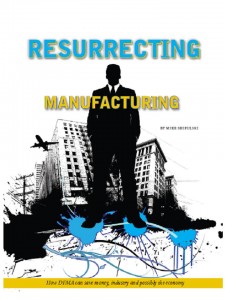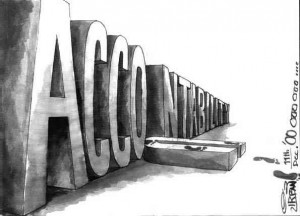Archive for the ‘DFA’ Category
What is Design for Manufacturing and Assembly?
Design for Manufacturing (DFM) is all about reducing the cost of piece-parts. Design for Assembly is all about reducing the cost of putting things together (assembly). What’s often forgotten is that function comes first. Change the design to reduce part cost, but make sure the product functions well. Change the parts (eliminate them) to reduce assembly cost, but make sure the product functions well.
Paradoxically, DFM and DFA are all about function.
Here’s a link to a short video that explains DFM and DFA: link to video. (and embedded below)
Secret Sauce that Doubles Profits
 Last month a group of engineers met secretly to reinvent the US economy one company at a time. Here are some of the players, maybe you’ve heard of them:
Last month a group of engineers met secretly to reinvent the US economy one company at a time. Here are some of the players, maybe you’ve heard of them:
Alcoa, BAE, Boeing, Bose, Covidien, EMC, GE Medical, GE Transportation, Grundfos, ITT, Medrad, Medtronic, Microsoft, Motorola, Pratt & Whitney, Raytheon, Samsung, Schneider Electric, Siemens, United Technologies, Westinghouse, Whirlpool.
Presenter after presenter the themes were the same: double profits, faster time to market, and better products – the triple crown of product development. Magic in a bottle, and still the best kept secret of the product development community. (No sense sharing the secret sauce when you can have it all for yourself.)
Microsoft used the secret sauce to increase profits of their hardware business by $75 million; Boeing recently elevated the secret methodology to the level of lean. Yet it’s still a secret.
What is this sauce that doubles profits without increasing sales? (That’s right, doubles.) What is this magic that decreases time to market? That reduces engineering documentation? That reduces design work itself? What is this growth strategy?
When trying to spread it on your company there are some obstacles, but the benefits should be enough to carry the day. First off, the secret sauce isn’t new, but double the profits should be enough to take a first bite. Second, its name doesn’t roll off the tongue (there’s no sizzle), but decreased time to market should justify a taste test. Last, design engineering must change its behavior (we don’t like to do that), but improved product functionality should be enough to convince engineering to swallow.
There are also two mapping problems: First, the sauce has been mapped to the wrong organization – instead of engineering it’s mapped to manufacturing, a group that, by definition, cannot do the work. (Only engineering can change the design.) Second, the sauce is mapped to the wrong word – instead of profit it’s mapped to cost. Engineering is praised for increased profits (higher function generates higher profits) and manufacturing is responsible for cost – those are the rules.
With double profits, reduced time to market, and improved product function, the name shouldn’t matter. But if you must know, its name is Design for Manufacturing and Assembly (DFMA), though I prefer to call it the secret sauce that doubles profits, reduces time to market, and improves product function.
I can name that tune in three notes.
 More with more doesn’t cut it anymore, just not good enough.
More with more doesn’t cut it anymore, just not good enough.
The behavior we’re looking for can be nicely described by the old TV game show Name That Tune, where two contestants competed to guess the name of a song with the fewest notes. They were read a clue that described a song, and ratcheted down the notes needed to guess it. Here’s the nugget: they challenged themselves to do more with less, they were excited to do more with less, they were rewarded when they did more with less. The smartest, most knowledgeable contestants needed fewer notes. Let me say that again – the best contestants used the fewest notes.
In product design, the number of notes is analogous to part count, but the similarities end there. Those that use the fewest are not considered our best or our most knowledgeable, they’re not rewarded for their work, and our organizations don’t create excitement or a sense of challenge around using the fewest.
For other work, the number of notes is analogous to complexity. Acknowledge those that use the fewest, because their impact ripples through your company, and makes all your work easier.
Pull the product lever, now.
 If you’re reading this you’ve probably survived the great recession. You had to do some radical stuff, but you pulled it off. You cut to the bone as demand fell off, but you managed to shed staff and capacity and kept your company alive. Congratulations. Amazing work. But now the hard part: increased demand!
If you’re reading this you’ve probably survived the great recession. You had to do some radical stuff, but you pulled it off. You cut to the bone as demand fell off, but you managed to shed staff and capacity and kept your company alive. Congratulations. Amazing work. But now the hard part: increased demand!
Customers are ordering, and they want product now. You’re bringing on capacity, re-hiring, and re-training, and taking waste out of your processes with lean and even extending lean to your supply chain and logistics. You’re pulling the levers as hard as you can, but you know it won’t be enough. What you need is another lever, a big, powerful, magical lever to make everything better. You need to pull the product lever.
So, you’re telling me to look at my product as a way to meet increased demand? Yes. To get more products out of few factories? Yes. To make more products with a short staff? Yes. To reduce supply chain complexity? Yes. Pull the product lever, pull it hard, and pull it now.
But meeting increased demand is a manufacturing/supply chain problem, right? No. What about flogging suppliers for unreasonably short lead times? No. What about quickly bringing on unproven suppliers? No. What about bringing on a totally new factory by next week? No. What about using folks of the street to make the product? No. Pull the product lever, pull hard, and pull it now.
Dust off the value stream map of your supply chain and identify the three longest lead times, and design them out of your product. Dust off your routings and identify the three largest labor times, and design them out of our product. Dust off your BOMs and identify the three highest cost parts, and design them out of your product. Pull the product lever. Then, identify the next three, and pull it again. Then repeat. Pull it hard, and pull it now.
Meeting increased demand will be challenging, but your customers and stockholders deserve your best. So, pull hard on all your levers, and pull them now.
Too afraid to make money and create jobs.
 What if you could double your factory throughput without adding people?
What if you could double your factory throughput without adding people?
What if you could reduce your product costs by 50%?
How much money would you make?
How many jobs would you create?
Why aren’t you doing it?
What are you afraid of?
Your product costs are twice what they should be.
 Your product costs are twice what they should be. That’s right. Twice.
Your product costs are twice what they should be. That’s right. Twice.
You don’t believe me. But why? Here’s why:
If 50% cost reduction is possible, that would mean you’ve left a whole shitpot of money on the table year-on-year and that would be embarrassing. But for that kind of money don’t you think you could work through it?
If 50% cost reduction is possible, a successful company like yours would have already done it. No. In fact, it’s your success that’s in the way. It’s your success that’s kept you from looking critically at your product costs. It’s your success that’s allowed you to avoid the hard work of helping the design engineering community change its thinking. But for that kind of money don’t you think you could work through it?
Even if you don’t believe 50% cost reduction is possible, for that kind of money don’t you think it’s worth a try?
Cure for offshoring: The design side of product development, from Machine Design
 A recent article written by Leslie Gordon of Machine Design.
A recent article written by Leslie Gordon of Machine Design.
You have probably seen it yourself: images of Chinese workers toiling in mud-floored factories, each feeding a separate punch press, as if part and parcel of a living, progressive die. The lure of this cheap labor has sent many U.S. manufacturers scrambling overseas to cut production costs.
Although design-for-manufacturing tools that would have made this exodus unnecessary have been around for more than 20 years, companies continue to overlook them, says Mike Shipulski, chief engineer of plasma-cutter manufacturer Hypertherm, hypertherm.com, Hanover, N.H. “Companies are sticking their heads in the sand. Many U.S. firms have become too entrenched in doing things the same way. For example, a typical product-cost breakdown shows material to be the largest cost at about 72%. Overhead is around 24% and labor is only about 4%. The question becomes, why continue to move manufacturing to so-called ‘low-cost countries’ to chase 50% labor reductions for a whopping 2% cost reduction? And it’s sillier than that because companies don’t account for cost increases in shipping and quality control.”
The problem is that companies neglect to efficiently account for cost during the design side of product development….
Bring It Back
 Companies (and countries) are slowly learning that moving manufacturing to low cost countries is a big mistake, a mistake of economy-busting proportion. (More costly than any war.) With labor costs at 10% of product cost, saving 20% on labor yields a staggering 2% cost savings. 2%. Say that out loud. 2%. Are you kidding me? 2%? Really? Moving machines all over the planet for 2%? What about cost increases from longer supply chains, poor quality, and loss of control? Move manufacturing to a country with low cost labor? Are you kidding me? Who came up with that idea? Certainly not a knowledgeable manufacturing person. Don’t chase low cost labor, design it out.
Companies (and countries) are slowly learning that moving manufacturing to low cost countries is a big mistake, a mistake of economy-busting proportion. (More costly than any war.) With labor costs at 10% of product cost, saving 20% on labor yields a staggering 2% cost savings. 2%. Say that out loud. 2%. Are you kidding me? 2%? Really? Moving machines all over the planet for 2%? What about cost increases from longer supply chains, poor quality, and loss of control? Move manufacturing to a country with low cost labor? Are you kidding me? Who came up with that idea? Certainly not a knowledgeable manufacturing person. Don’t chase low cost labor, design it out.
(I feel silly writing this. This is so basic. Blocking-and-tackling. Design 101. But we’ve lost our way, so I will write.)
Use Design for Assembly (DFA) and Design for Manufacturing (DFM) to design out 25-50% of the labor time and make product where you have control. The end. Do it. Do it now. But do it for the right reasons – throughput, and quality. (And there’s that little thing about radical material cost reduction which yield cost savings of 20+%, but that’s for another time).
The real benefit of labor reduction is not dollars, it’s time. Less time, more throughput. Half the labor time, double the throughput. One factory performs like two. Bring it back. Fill your factories. Repeat the mantra and you’ll bring it back:
Half the labor and one factory performs like two.
QC stands for Quality Control. No control, no quality. Ever try to control things from 10 time zones in the past? It does not work. It has not worked. Bring it back. Bring back your manufacturing to improve quality. Your brand will thank you. Put the C back in QC – bring it back.
Forward this to your highest level Design Leaders. Tell them they can turn things around; tell them they’re the only ones who can pull it off; tell them we need; tell them we’re counting on them; tell them we’ll help; tell them to bring it back.
Anyone want to save $50 billion?
 I read a refreshing article in the Washington Post. Defense Secretary Robert M. Gates wants to save $20B per year on the Pentagon’s spend. I could kiss this guy!
I read a refreshing article in the Washington Post. Defense Secretary Robert M. Gates wants to save $20B per year on the Pentagon’s spend. I could kiss this guy!
Gates wants contracts scrutinized more closely for inefficiencies and unneeded overhead. He said the savings could be shifted to support U.S. troops around the globe. Pentagon officials said they’re looking for annual savings in the $400 billion spent on goods and services. They’re looking to save $20B, or 5%.
Gates has it right. The government must stop overpaying. But how? Gates suggests improved contract scrutiny to eliminate inefficiencies and unneeded overhead. He’s on the right track, but that’s not where the money is. Gates’ real target should be material cost – that’s where the money is. But, can material cost bring $20B savings? Yes.
Assume the Pentagon spends $100B on services and $300B on goods. The cost of those of goods falls into three buckets: labor, material, and overhead, where material cost makes up the lion’s share at 70%, or $210B. A 10% reduction in material cost brings $21B in savings, and gets Gates to his target. But how?
To get the savings, the Pentagon must drive the right behavior. They must must make suppliers submit a “should cost” with all proposals. The should cost is an estimated cost based on part geometries, materials, manufacturing processes used to create the parts, prevailing wage rates and machine rates, and profit. From these parameters, a should cost can be created in the design phase, without actually making the parts. So, the Pentagon will know what they should pay before the product is made. This cost analysis is based on real data, real machines, and real material costs. There is no escape for defense contractors. The cash cow is no longer.
Should costing will drive the design engineers to create designs that work better and cost less, something the defense industry thinks is impossible. They’re wrong. Given the tools, time, and training, the defense industry’s design engineering community can design out at least 25% of material cost, resulting in $50B+ in savings, more than twice Gates’ goal. Someone just has to teach them how.
Mr. Secretary, the non-defense world is ready to help. Just ask us. (But we’ll go after a 50% cost reduction.)
Cover Story IE Magazine – Resurrecting Manufacturing
 For too long we have praised financial enterprises for driving economic growth knowing full well that moving and repackaging financial vehicles does not create value and cannot provide sustainable growth. All the while, manufacturing as taken it on the chin with astronomical job losses, the thinnest capital investments and, most troubling, a general denigration of manufacturing as an institution and profession. However, we can get back to basics where sustainable economic growth is founded on the bedrock of value creation through manufacturing.
For too long we have praised financial enterprises for driving economic growth knowing full well that moving and repackaging financial vehicles does not create value and cannot provide sustainable growth. All the while, manufacturing as taken it on the chin with astronomical job losses, the thinnest capital investments and, most troubling, a general denigration of manufacturing as an institution and profession. However, we can get back to basics where sustainable economic growth is founded on the bedrock of value creation through manufacturing.
Continuing with the back-to-basics theme, manufacturing creates value when it combines raw materials and labor with thinking, which we call design, to create a product that sells for more than the cost to make it. The difference between cost (raw materials, labor) and price is profit. The market sets price and volume so manufacturing is left only with materials and labor to influence profit. At the most basic level, manufacturing must reduce materials and labor to increase profit. We can get no more basic than that. How do we use the simple fundamentals of reducing labor and material costs to resurrect U.S. manufacturing? We must change our designs to reduce costs using Design for Manufacturing and Assembly (DFMA).
The program is typically thought of as a well-defined toolbox used to design out product cost. However, this definition is too narrow. More broadly, DFMA is a methodology to change a design to reduce the cost of making parts while retaining product function. Systematic DFMA deployment is even broader; it is a business method that puts the business systems and infrastructures to deploy DFMA methods in place systematically across a company. In that way, it is similar to the better known business methodologies lean, Six Sigma and design for Six Sigma.
Click this link for the full story.
a
Click this link for information on Mike’s upcoming workshop on Systematic DFMA Deployment
Who owns cost?
 I’ve heard product cost is designed in; I’ve heard it happens at the early stages of product development; And, I’ve heard, once designed in, cost is difficult get out. I’m sure you’ve heard this before. Nothing new here. But, is it true? Is cost really designed in? Why do I ask? Because we don’t behave like it’s true. Because was it was true, the Design community would be responsible for product costs. And they’re not.
I’ve heard product cost is designed in; I’ve heard it happens at the early stages of product development; And, I’ve heard, once designed in, cost is difficult get out. I’m sure you’ve heard this before. Nothing new here. But, is it true? Is cost really designed in? Why do I ask? Because we don’t behave like it’s true. Because was it was true, the Design community would be responsible for product costs. And they’re not.
Who gets flogged when the cost of new products are too high? Manufacturing. Who does not? Design. Who gets stuck running cost reduction projects when costs are too high? Manufacturing. Who does not? Design. Who gets the honor of running kaizens when value stream maps don’t have enough value? Manufacturing. Who designs out the value and designs in the cost? Design. (That’s why they’re called Design.) If Design designs it in, why is the cost albatross hung around Manufacturing’s neck?
It sucks to be a manufacturing engineer – all the responsibility to reduce cost without the authority to do it. The manufacturing engineers’ call to arms –
a
Reduce cost, but don’t change anything!
a
Say that out loud. Reduce the cost, but don’t change anything. How stupid is that? We’ll it’s pretty stupid, but it happens every day. And why constrain the manufacturing engineers like that? Because they don’t have the authority to change the product design – only Design can do that. So you’re saying Manufacturing is responsible for product cost, but they cannot change the very thing that creates all the cost? Yes.
What would life be like if we behaved as if Design was responsible for product cost? To start, Design would present product cost data at new product development gate reviews. Design would hang their heads when product costs were higher than the cost target, and they would be held accountable for redesigning the product and meeting the cost target. (They would also be given the tools, time, and training to do the work.)
Going forward, Design would understand the elements of product that create the most cost. And how would they know this? First, they would spend some time on the production floor. (I know this is a little passé, but it still works.) Second, they would do Design for Assembly (DFA) in a hands-on, part-by-part, piece-by-piece way. No kidding, they would handle all the parts themselves, assemble them with production tooling, and score the design with DFA. That’s right, Design would do DFA. The D in DFA does not stand for Advanced Manufacturing, Operations, Supplier Quality, Purchasing, or Industrial Engineering. The D stands for Design.
I know your manufacturing engineers are in favor of rightly burdening Design with responsibility for product cost. But, your Lean Leaders should be the loudest advocates. Imagine if your Design organization designed new products with half the parts and half the material cost, and your Lean Leaders reduced value waste from there. Check that, Lean Leaders should not be the loudest advocates. Your stockholders should be.
Click this link for information on Mike’s upcoming workshop on Systematic DFMA Deployment
 Mike Shipulski
Mike Shipulski